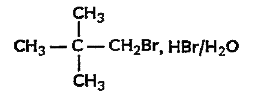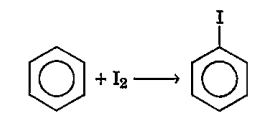Name the reactant and reagent used to obtain n-propyl alcohol:




The correct Answer is:B
To obtain n-propyl alcohol (also known as 1-propanol), we can use a specific reactant and reagent. Here is a step-by-step solution to identify them:
Step 1: Understand the Structure of n-Propyl Alcohol
n-Propyl alcohol has the molecular formula C3H8O and its structure can be represented as CH3-CH2-CH2-OH. This indicates that it is a straight-chain alcohol with three carbon atoms.
Hint: Remember that n-propyl alcohol is a straight-chain alcohol, which is important for identifying the correct reactant and reagent.
Step 2: Identify the Suitable Reactant
To synthesize n-propyl alcohol, we can start with an epoxide. An epoxide is a cyclic ether with a three-membered ring, which can be opened up to form alcohols.
Hint: Look for a reactant that can undergo ring-opening to yield a straight-chain alcohol.
Step 3: Choose the Correct Reagent
The reagent we can use is a Grignard reagent, specifically methylmagnesium bromide (CH3MgBr). This reagent is highly reactive and will react with the epoxide to form n-propyl alcohol.
Hint: Grignard reagents are useful for forming alcohols from epoxides by nucleophilic attack.
Step 4: Reaction Mechanism
When CH3MgBr is added to the epoxide, the nucleophilic methyl group (CH3-) attacks the less sterically hindered carbon of the epoxide. This leads to the opening of the epoxide ring and the formation of a new carbon-carbon bond, resulting in the formation of n-propyl alcohol.
Hint: Understand that the mechanism involves nucleophilic attack and ring-opening of the epoxide.
Step 5: Final Product
After the reaction, we will have n-propyl alcohol (CH3-CH2-CH2-OH) as the final product.
Hint: Make sure to verify the final structure to confirm that it matches n-propyl alcohol.
Conclusion
The reactant used is an epoxide, and the reagent used is methylmagnesium bromide (CH3MgBr). The reaction involves the nucleophilic attack of the Grignard reagent on the epoxide, leading to the formation of n-propyl alcohol.
Summary
- Reactant: Epoxide
- Reagent: Methylmagnesium bromide (CH3MgBr)
n-Propyl alcohol has the molecular formula C3H8O and its structure can be represented as CH3-CH2-CH2-OH. This indicates that it is a straight-chain alcohol with three carbon atoms.
To synthesize n-propyl alcohol, we can start with an epoxide. An epoxide is a cyclic ether with a three-membered ring, which can be opened up to form alcohols.
The reagent we can use is a Grignard reagent, specifically methylmagnesium bromide (CH3MgBr). This reagent is highly reactive and will react with the epoxide to form n-propyl alcohol.
When CH3MgBr is added to the epoxide, the nucleophilic methyl group (CH3-) attacks the less sterically hindered carbon of the epoxide. This leads to the opening of the epoxide ring and the formation of a new carbon-carbon bond, resulting in the formation of n-propyl alcohol.
After the reaction, we will have n-propyl alcohol (CH3-CH2-CH2-OH) as the final product.
The reactant used is an epoxide, and the reagent used is methylmagnesium bromide (CH3MgBr). The reaction involves the nucleophilic attack of the Grignard reagent on the epoxide, leading to the formation of n-propyl alcohol.
- Reactant: Epoxide
- Reagent: Methylmagnesium bromide (CH3MgBr)
Topper's Solved these Questions
- SAMPLE PAPER 02BOOK - EDUCART PUBLICATIONCHAPTER - SAMPLE PAPER 02EXERCISE - SECTION - C
6 Videos
- SAMPLE PAPER 02BOOK - EDUCART PUBLICATIONCHAPTER - SAMPLE PAPER 02EXERCISE - SECTION - C
6 Videos
- SAMPLE PAPER 01BOOK - EDUCART PUBLICATIONCHAPTER - SAMPLE PAPER 01EXERCISE - SECTION-C
5 Videos
- SAMPLE PAPER 04BOOK - EDUCART PUBLICATIONCHAPTER - SAMPLE PAPER 04EXERCISE - SECTION C
6 Videos
Similar Questions
Knowledge Check
What would be the reactant and reagent used to obtain 2,4 - dimethylpentan-3-ol ?
APropanal and proyl magnesium bromideB3-Methybutanal and 2- methyl magnesium iodideC2,2-Dimethylpropanone and methyl magnesium iodideD2- Methylpropanal and isopropyl magnesium iodideName the reagent used in this reaction.
 AHNO3BHFCH2ODSO2
AHNO3BHFCH2ODSO2The reagent used to get alkyl halide from alcohol is
APCl5BSOCl2Cboth 1 & 2DCl2
Explain by writing a reaction, what will happen when pieces of sodium metal are put in n-propyl alcohol.
View SolutionThe intermediate formed in the acid catalysed dehydration of n-propyl alcohol is
View SolutionWhich of the following reagents can be used to oxidise primary alcohols to aldehydes ?
View SolutionWhich of the following reagents can be used to oxidise primary alcohols to aldehydes ?
View SolutionThe reagent used for the dehydration of an alcohol is :
View Solution